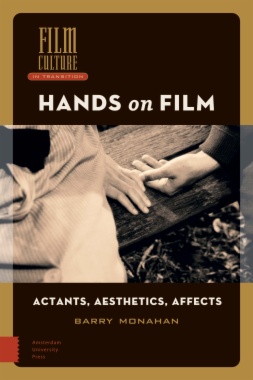Hands on Film is a comprehensive study of the representations and on-screen uses of the human limb, spanning the history of the cinema from its birth to contemporary times. It examines how filmmakers have framed the hand for a variety of effects, from stylistic to thematic, and for the development of characterisation and narrative. The book offers insights into how films have created meaning by focusing on that part of the anatomy and, in turn, proposes a variety of ways in which its on-screen appearances might shed light on what it means to be sentient, cultured, and creative beings in the world.
- Cover
- Table of Contents
- Acknowledgements
- Introduction
- 1. Themes – The Framed Hand and Being
- Natural and Supernatural Phenomena: Matter Becoming Consciousness
- The Nature and Origin of Creativity
- Determinism and Free Will: Possession, Self-possession, Dispossession
- Modernism: Industrialisation and Technology
- Gendered Hands
- Works Referenced
- 2. Symbolism – The Semiotic Hand
- The Meaningful Hand and Metonymy
- The Manual as Metaphorical
- Between Metaphor and Metonym: The Hand and Memory
- Works Referenced
- 3. Aesthetics – The Stylised Hand: Beauty, Ugliness, Genre
- Behind the Scenes: Unseen Creative Hands
- The Stylised Hand on Screen
- The Camp Hand and the Hand in Camp
- The Haptic Experience: Screened Sensations
- Works Referenced
- 4. Narration – Hands Doing and Being
- Hands as Narrative Actants
- Slow Hands and Slow Cinema
- Acting Hands and Set Pieces
- Works Referenced
- 5. Characterisation – Hands and Identity
- Cultural Contexts for Creative and Destructive Personalities
- The Psychopathic Hand
- Vocational Hands
- Characters and Labour
- Manual Details: Emotions and Eccentricities
- Concealing and Revealing Characters
- Works Referenced
- Concluding Case Study – Steven Spielberg’s Jaws (1975)
- Filmography
- Index
- List of Images
- Figure 1.1: Divinely created contorted female hands in The House is Black (Forugh Farrokhzad, 1963)
- Figure 1.2: The protagonist enjoys her secret manual pleasure in Amélie (Jean-Pierre Jeunet, 2001)
- Figure 1.3: The hand of fate in Amélie (Jean-Pierre Jeunet, 2001)
- Figure 2.1: Bruno takes hold of Caroline’s hands in Le lit (Marion Hänsel, 1982)
- Figure 2.2: Hands trap the cricket, symbolising repressed emotion in Cecil Tang’s The Arch (1968)
- Figure 2.3: Workman’s gloves inhibit the emotional connection between father and son in Five Easy Pieces (Bob Rafelson, 1970)
- Figure 2.4: Manual touch invokes memory in Hiroshima mon amour (Alain Resnais, 1959)
- Figure 3.1: Hands and the style of German Expressionism in The Cabinet of Dr. Caligari (Robert Wiene, 1920)
- Figure 3.2: Hands as stylistic elements in The House is Black (Forugh Farrokhzad, 1963)
- Figure 3.3: Stylised destruction of the evil limb in Dr. Terror’s House of Horrors (Freddie Francis, 1965)
- Figure 3.4: Stylised mise en scène in Harold P. Warren’s Manos: The Hands of Fate (1966)
- Figure 3.5: Camp hands as functioning objets d’art in Jean Cocteau’s La Belle et la bête (1947)
- Figure 4.1: The skilled hand in action in Robert Bresson’s Pickpocket (1959)
- Figure 4.2: The pervasive threatening hand in Dr. Terror’s House of Horrors (Freddie Francis, 1965)
- Figure 5.1: Lacenaire presents his criminal and creative hands in Les enfants du paradis (Marcel Carné, 1945)
- Figures 5.2: Identification intensified with the silent characters in Lorenza Mazzetti’s Together (1956)
- Figures 5.3: Characterisation through manual communication in Lorenza Mazzetti’s Together (1956)
- Figure 5.4: The lovers’ manual interactions in L’Eclisse (Michelangelo Antonioni, 1962)

